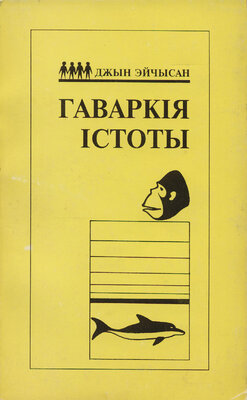Гаваркія істоты
Уводзіны ў псіхалінгвістыку
Джын Эйчысан
Выдавец: Беларускі Фонд Сораса
Памер: 220с.
Мінск 1995
Mehler, J., Jusczyk, P., Lambertz, G., and halsted, N. (1988), «А precursor of language acquisition in young infants»? Cognition, 29, pp. 143-78
Miles, H.L. (1983), «Apes and language: the search forcommunicztive comoetence», in de Luce and Wilder (1983)
Miller, G.A. (1962), «Some psychological studies of grammar», American Psychologist, 1, pp. 748-62, also in Jakobovits and Miron (1967) and De Cecco (1967)
Miller, G.A., and Chomsky, N. (1963), «Finitary models of language users», in Luce, Bush and Galanter (1963)
Miller, G.A., and Lenneberg, E. (1978), Psychology and Biology of Language and Thought, New York: Academic Press
Miller, G.A., and McKean, K. (1964), «А chronometric study of some relstions between sentences», Quarterly Journalof Experimental Psychology, 16, pp. 297-308. Also in Oldfield and Marxhall (1968)
Miller, W., and Ervin, S. (1964), «The development of grammer in child language», in Bellugi and Brown (1964)
Milner, B., Branch, C., and Rasmussen, T. (1964), «Observations on cerebral dominance», in DeReuckand O’Connor (1964). Also in Oldfield and Marshall (1968)
Modgil, S., and Modgil.C (1987), Noam Chomsky: Consensus and Controversy, Philadelphia, Pa: The Falmer Press
Morse, P.A. (1976), «Speech perception in the human infant and rhesus monkey», in S.Harnad, H. Steklis and J.Lancaster (eds), Origins and evolution of language and speech, Annals of the New York
Academy of Sciences, vol. 280
Morton, J. (1971), «What could possibly be innate?», in J.Morton (ed.), Biological and Social Factors in Psycholinguistics, London: Logos Press
Moscovitch, M. (1983), «Stage of processing and hemisphere differences in language in the normal subject», in Studdert-Kennedy (1983)
Motley, M.T. (1985), «Slips of the tongue», Scientific American, 253 (September), pp. 114-19
Nelsin, K. (1973), Structure and strategy in learning to talk, Monograph of the Society for Research in Child Development, 38, pp. 1-2
Nelson, K. (1980), Children's Language, vol. 2, New York: Gardner
Press v
Newmeyer, FJ. (1986), Linguistic Theory in America (2nd edn), New
York: Academic Press
Newmeyer, FJ. (1988), Linguistics: The Cambridge Survey, vols. 14, Cambridge: Cambridge University Press
Newport, E.L., Gleitman, H., and Gleitman, L.R. (1977), «Mother I’d rather do it myself: the contribution of selected child listener variables», in Snow and Ferguson (1977)
Nishigauchi,T.,and Roeper,T. (1987),«Deductive parametersand the growth of empty categories», in Roeper and Williams (1987)
Nooteboom, S.G. (1969), «The tongue slips into patterns», in A.G.Sciarone et al. (eds), Nomen: Leyden Studies in Linguistics and Phonetics, The Hague: Mouton. Also in Fromkin (1973)
Nottebohm, F. (1975), «А zoologist’s view of some language phenomena with particular emphasis on vocalleatning», in Lenneberg and Lenneberg (1975), vol.1
Notterbohm, F. (1984), «Vocal lerning and its possible relation to replaceable synapses and neurons», in Caplan, Lecours and Smith (1984)
O’Grady, W. (1989), «The Transition from optional to required subjects», Journal of Child Language
Oldfield, R C., and Marshall, J.C. (1968), Language: Selected Readings, Harmondsworth: Penguin
Osherson, D.N.,and Wason.T. (1976), «Task specificity and speciesspecificity in the study of language: a methodological note», Cognition, 4, pp. 203-14
Padden, C.A. (1988), «Grammatical theory and signed languages», in Newmeyer (1988), vol.2
Patterson, F.G. (1978), «The gestures of a gorilla: language acquisition in another pongid», Brain and Language, 5, pp. 72-97
Patterson, F.G. (1980), «Innovative uses of language by a gorilla: a case study», in Nelson (1980)
Patterson, F.G., and Linden, E. (1981), The Education of Koko, New
York: Holt, Reinhart and Winston
Peirce, C.S. (1932), Collected Papers of Charles Sanders Peirce, vol.2 edited by C.Hartshorne and P.Weiss, Cambridge, Mass: Harvard University Press
Penfield, W-, and Roberts, L. (1959), Speech and brain mechanisms, Princeton, NJ: Princeton University Press
Peters, A.M. (1977), «Language learning stategies does the whole equal the sum of the parts?», Language, 53, pp. 560-73
Peters, A.M. (1983), The Units of Language Acquisition, Cambridge:
Cambridge University Press
Petito, L.A., and eidenberg, M.S. (1979), «On the evidence tor linguistec abilites in signing apes», Brain and Language, 8, pp. 162-83
Pinier, S. (1984), Language Learnability and Language Development, Cambridge, Mass: Harvard University Press
Pinker, S. (1987), «The bootstrapping problem in language acquisition», in MacWhinney (1987)
Pinker, S., and Prince, A. (1988), «On language and connectionism: analysis ot a parallel distributed processing model of language acquisition», Cognition< 28, pp. 73-193
Premack, A.. (1976), Why Chimps Can Read, New York: Harper and Row
Premack, D. (1970), «The education of Sarah», Psychology Today, 4, pp. 55-8
Premack, D. (1971), «Language in chimpanzee?», Science, 172. pp. 808-22
Premack, D. (1972), «Teaching language to an ape», Scientific American (October), pp. 92-9
Premack, D. (1976), Intelligence in Ape and Man, Hillsdale, NJ: Lawrence Erlbaum Assiciates
Premack, D.,and Premack, AJ. (1974), «Teaching visuall language to apes and language-deficient persons», in Schiefelbusch and Lioyd (1974)
Premack, D., amd Premack, A J. (1983), The Mind of an Ape, New York: Norton
Radford, A. (1988), Transformational Grammar: A First Course, Cambridge: Cambridge University Press
Radford, A. (1988a), «Small children’s small ciauses», Transactions of the Philogical Society, 86, pp. 1-43
Randall, J. (1987), \ndirect Positive Evidence: Overturning Generalizations in Language Acquisition, Bloomington, Ind: Indiana University Linguistics Club
Reich, P.A. (1986), Language Development, Englewood Cliffs, NJ: Prentice-Hall
Richards, D.G., Wolz, J.P., and erman, L.M. (1984), «Mimicry of computer-generated sounds and vocallabeling of objects by a bottlenosed dolphin», Journal of Comparative Psychology, 98, pp. 10-28
Ricks, D.M. (1975), «Vocal communication in pre-verbal normal and autistic children», in N.O’Connor (ed), Language, Cognitive Deficits, and Retardation, London: Butterworth
Roeper, ., and Matthei, E. (1983), Understanding and Producing Speech, London: Fontana
Roeper, T., and Williams, E. (1987), Parameter Setting, Dordrecht: Reidel
Rosenberg, S., and oplin, J.H. (1986), Developments in Applied Psycholinguistics Research, New York: Macmillan
Rosenfield, D. (1978), «Some neurological techniques for accessing localization of function», in Walker (1978)
umbaugh, D.M. (1977), Language Learning by a Chimpanzee. The LANA Project, New York: Academic Press
Rumelhart, D.E., Hinton, G.E., and McClelland, J.L. (1986), « A general framework for parallel distributed processing», in umelhart and cClelland (1986)
Rummelhart, D.E., and McClelland, J.L. (1986), Parallel Distributed Processing: Explorations in the Microstructure of Cognition, vol. 1: Foundations, Cambridge, Mass: MIT PressRumelhart, D.E., and cClelland, J.L. (1987), «Learning the past tense of English verbs: Implicit rules or parallel distributed processing?», in MacWhinney (1987). Also in McClellsnd and Rumelhart (1986)
Sachs, J.S. (1967), «Recognition memory for syntactic and semantic aspects of connected discourse», Perception and Psychophysics, 2, pp. 437-42
Sampson, G. (1975), The Form of Language, London: Weidenfeid and Nicolson
Sampson, G. (1980), Making Sense, Oxford: Oxford University Press
SAmpson, G. (1987), Review of Rumelhart and McClelland (1986), Language, 63, pp. 871-86
Saporta, S. (1961), Psycholinguistics: A Book of Readings, New York: Holt, Reinhart and Winston
Savage Rumbaugh, E.S. (1986), Ape Language: rom Conditioned Response to Symbol, Oxford: Oxford University Press
Savage Rumbaugh, E., and Rumbaugh, D.M. (1980), «Language analogue project, phase II: theory and tactics», in Nelson (1980)
Savin, H., and Perchonock., (1965), «Grammatical structure and the immediate recall of English sentences», Journal of Verbal Learning and erbal Behavior, 4, pp. 348-53
Schiefelbusch, R.L., and Lloyd, L.L. (1974), Language Perspectives — Acquisition,’ Retardation, and Intervention, Baltimore: University Park Press
Schlesinger, I.. (1967), «А note on the relationship between psychological and linguistic theories», Foundations of Language, 3. pp. 397402
Schlesinger, I.. (1971), «Production of utterances and language acquisition», in Slobin (1971)
Scovel, T. (1988), A time to Speak: A Psycholinguistic Examination of the Critical Period for Language Acquisition, Rowley, Mass: Newbury House
Sebeok, T.A. (1977), How Animals Communicate, Indiana: Indiana University Press
Sebeok, T.A., and Umiker-Sebeok, J. (1979), Speaking of Apes: A Critical Anthology of Two-Way ommunication with Manm New York: Plenum
Sebeok, T.A., and Rosenthal, R. (1981), The Clever Hans Phenom
enon: Communication with Horses, Whales, Apes and People, New York: The New York Academy of Sciences
Sebeok, T.A., and Umilker-Sebeok, J. (1980), What the Speechless Creatures Say, Bloomington: Indiana University Press
Seidenberg, M.S., Tanenhaus, M.., Leiman, J.M., and Bienkowski, M. (1982), «Automatic access of the meaning of ambiguous words in context: some limitations of knowledge-based processing», Cognitive Psychology, 14, pp. 481-537
Sells, P. (1985), Lectures on Contemporary Syntactic Theories, Stanford, Cal: Stanford University Center for the Study of Language and Information
Seyfarth, R.M., Cheney, D.L., and Marler, P. (1980), « Monkey responses to three different alarm calls: evidence for predator classification and semantic communication», Science, 210, pp. 801-3
Seyfarth, R.M., Cheney, D.L., and Marler, P. (1980a), «Vervet monkey alrm calls: semabtic communication in a free-ranging primate», Animal ehavior, 28, pp. 1070-94
Shapiro, L.P., Zurif, E., and Grimshaw, J. (1987), «Sentence processing and the mental representation of verbs», Cognition, 27, pp. 219-46
 КНІГІ ОНЛАЙН
КНІГІ ОНЛАЙН


